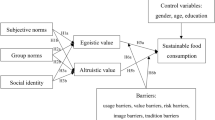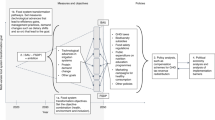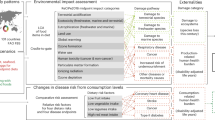Abstract
The social dimension of sustainable diets, which addresses the impacts of food value chains on people, animals and communities, is under-represented in the food systems field. We present a definition of the social dimension of sustainable diets, clarify its boundaries and propose corresponding outcomes. Three case studies highlight the connectivity of social outcomes with the health, environment and economic dimensions of sustainable diets. The continued development of social metrics, data and methods and the implementation of integrated solutions co-developed with affected communities are needed to transform systems and structures that perpetuate unjust and inequitable food systems outcomes.
This is a preview of subscription content, access via your institution
Access options
Access Nature and 54 other Nature Portfolio journals
Get Nature+, our best-value online-access subscription
$32.99 / 30 days
cancel any time
Subscribe to this journal
Receive 12 digital issues and online access to articles
$119.00 per year
only $9.92 per issue
Buy this article
- Purchase on SpringerLink
- Instant access to full article PDF
Prices may be subject to local taxes which are calculated during checkout

Similar content being viewed by others
References
The State of Food Security and Nutrition in the World 2023: Urbanization, Agrifood Systems Transformation and Healthy Diets across the Rural–Urban Continuum (FAO, IFAD, UNICEF, WFP & WHO, 2023); https://doi.org/10.4060/cc3017en
Springmann, M. et al. Health and nutritional aspects of sustainable diet strategies and their association with environmental impacts: a global modelling analysis with country-level detail. Lancet Planet. Health 2, e451–e461 (2018).
Estimating Global and Country-Level Employment in Agrifood Systems (FAO, 2023); https://doi.org/10.4060/cc4337en
Willett, W. et al. Food in the Anthropocene: the EAT–Lancet Commission on healthy diets from sustainable food systems. Lancet 393, 447–492 (2019).
Springmann, M., Clark, M. A., Rayner, M., Scarborough, P. & Webb, P. The global and regional costs of healthy and sustainable dietary patterns: a modelling study. Lancet Planet. Health 5, e797–e807 (2021).
Webb, P. et al. Measurement of diets that are healthy, environmentally sustainable, affordable, and equitable: a scoping review of metrics, findings, and research gaps. Front. Nutr. 10, 1125955 (2023).
Biesbroek, S. et al. Toward healthy and sustainable diets for the 21st century: importance of sociocultural and economic considerations. Proc. Natl Acad. Sci. USA 120, e2219272120 (2023).
Mazac, R., Renwick, K., Seed, B. & Black, J. L. An approach for integrating and analyzing sustainability in food-based dietary guidelines. Front. Sustain. Food Syst. 5, 544072 (2021).
Sustainable Healthy Diets—Guiding Principles (FAO & WHO, 2019).
Guidelines for Social Life Cycle Assessment of Products and Organisations 2020 (United Nations Environment Programme, 2020).
Traverso, M. et al. Methodological Sheets for Subcategories in Social Life Cycle Assessment (S-LCA) 2021 (Life Cycle Initiative, 2021); https://www.lifecycleinitiative.org/library/methodological-sheets-for-subcategories-in-social-life-cycle-assessment-s-lca-2021/#:~:text=The%20Methodological%20Sheets%20for%20subcategories,the%20application%20of%20S%2DLCA
Chaudhary, A. & Krishna, V. Region-specific nutritious, environmentally friendly, and affordable diets in India. One Earth 4, 531–544 (2021).
Downs, S. M., Payne, A. & Fanzo, J. The development and application of a sustainable diets framework for policy analysis: a case study of Nepal. Food Policy 70, 40–49 (2017).
Ahmed, S., Downs, S. & Fanzo, J. Advancing an integrative framework to evaluate sustainability in national dietary guidelines. Front. Sustain. Food Syst. 3, 76 (2019).
Downs, S. M., Ahmed, S., Fanzo, J. & Herforth, A. Food environment typology: advancing an expanded definition, framework, and methodological approach for improved characterization of wild, cultivated, and built food environments toward sustainable diets. Foods 9, 532 (2020).
Clapp, J., Moseley, W. G., Burlingame, B. & Termine, P. Viewpoint: the case for a six-dimensional food security framework. Food Policy 106, 102164 (2022).
Blackstone, N. T. et al. Forced labour risk is pervasive in the US land-based food supply. Nat. Food 4, 596–606 (2023).
Drewnowski, A. The Chicago consensus on sustainable food systems science. Front. Nutr. 4, 74 (2018).
LeBaron, G., Howard, N., Thibos, C. & Kyritsis, P. Confronting Root Causes: Forced Labour in Global Supply Chains (openDemocracy & SPERI, 2018); https://eprints.whiterose.ac.uk/126167/1/Confronting_Root_Causes_Forced_Labour_In_Global_Supply_Chains.pdf
Safety and Health in Agriculture: ILO Code of Practice (ILO, 2011); https://www.ilo.org/resource/other/safety-and-health-agriculture
Allain, J., Crane, A., LeBaron, G. & Behbahani, L. Forced Labour’s Business Models and Supply Chains (JRF, 2013); https://research.monash.edu/en/publications/forced-labours-business-models-and-supply-chains
Forsythe, L. Gender-based violence in food systems. Nat. Food 4, 472–475 (2023).
Costa, D. & Martin, P. How much would it cost consumers to give farmworkers a significant raise? Working Economics Blog https://go.nature.com/3XN4jBS (2020).
Kurtz, J., Blackstone, N. T., Sparks, J. L. D., Rodriguez, R. & Pinto, C. The true cost of labour must be worker-defined. Nat. Food 2, 630–631 (2021).
Coleman-Jensen, A., Rabbitt, M., Gregory, C. & Singh, A. Household Food Security in the United States in 2021 (U.S. Department of Agriculture & Economic Research Service, 2022).
Huang, J., Neufeld, L. M., Badiane, O., Caron, P. & Forsse, L. S. Equitable livelihoods must underpin food systems transformation. Nat. Food 3, 394–396 (2022).
Halpern, B. S. et al. The environmental footprint of global food production. Nat. Sustain. 5, 1027–1039 (2022).
Battaglia Richi, E. et al. Health risks associated with meat consumption: a review of epidemiological studies. Int. J. Vitam. Nutr. Res. 85, 70–78 (2015).
Elson, H. A. Poultry welfare in intensive and extensive production systems. World Poultry Sci. J. 71, 449–460 (2015).
Tainika, B., Şekeroğlu, A., Akyol, A. & Waithaka Ng’ang’a, Z. Welfare issues in broiler chickens: overview. World Poultry Sci. J. 79, 285–329 (2023).
Kirychuk, S. P. et al. Total dust and endotoxin in poultry operations: comparison between cage and floor housing and respiratory effects in workers. J. Occup. Environ. Med. 48, 741–748 (2006).
Autenrieth, D. A., Brazile, W. J., Douphrate, D. I., Román-Muñiz, I. N. & Reynolds, S. J. Comparing occupational health and safety management system programming with injury rates in poultry production. J. Agromed. 21, 364–372 (2016).
Constance, D. H., Martinez-Gomez, F., Aboites-Manrique, G. & Bonanno, A. in The Ethics and Economics of Agrifood Competition Vol. 20 (ed. James, H. S.) 155–175 (Springer, 2013).
Contract Broiler Growers Have Higher Median But a Greater Range of Household Income Compared to All U.S. Farms and Households (Economic Research Service, USDA, 2020); https://www.ers.usda.gov/data-products/chart-gallery/gallery/chart-detail/?chartId=104677
Ponce-Caballero, C., Cardeña-Echalaz, F., Giácoman-Vallejos, G., de Lille, M. V. & Góngora-Echeverría, V. R. Pesticide management and farmers perception of environmental and health issues due to pesticide use in the state of Yucatán, Mexico: a study case. Rev. Int. Contam. Amb. 38, 289–300 (2022).
Costa, L. G. in Casarett & Doull’s Toxicology: The Basic Science of Poisons 9th edn (ed. Klaassen, C. D.) Ch. 22 (McGraw-Hill Education, 2019).
Polanco Rodríguez, A. G. et al. Contamination by organochlorine pesticides in the aquifer of the Ring of Cenotes in Yucatán, México: contamination by organochlorine pesticides. Water Environ. J. 29, 140–150 (2015).
Perera-Rios, J. et al. Agricultural pesticide residues in water from a karstic aquifer in Yucatan, Mexico, pose a risk to children’s health. Int. J. Environ. Health Res. 32, 2218–2232 (2022).
Polanco Rodríguez, Á. G. et al. Levels of persistent organic pollutants in breast milk of Maya women in Yucatan, Mexico. Environ. Monit. Assess. 189, 59 (2017).
Rodríguez, A. G. P., López, M. I. R., Casillas, Á. D., León, J. A. A. & Banik, S. D. Impact of pesticides in karst groundwater. Review of recent trends in Yucatan, Mexico. Groundwater Sustain. Dev. 7, 20–29 (2018).
Coman, M. A., Marcu, A., Chereches, R. M., Leppälä, J. & Van Den Broucke, S. Educational interventions to improve safety and health literacy among agricultural workers: a systematic review. Int. J. Environ. Res. Public Health 17, 1114 (2020).
Afshari, M., Karimi-Shahanjarini, A., Khoshravesh, S. & Besharati, F. Effectiveness of interventions to promote pesticide safety and reduce pesticide exposure in agricultural health studies: a systematic review. PLoS ONE 16, e0245766 (2021).
Fanzo, J. et al. Viewpoint: rigorous monitoring is necessary to guide food system transformation in the countdown to the 2030 global goals. Food Policy 104, 102163 (2021).
Chaudhary, A., Gustafson, D. & Mathys, A. Multi-indicator sustainability assessment of global food systems. Nat. Commun. 9, 848 (2018).
Béné, C. et al. Global map and indicators of food system sustainability. Sci. Data 6, 279 (2019).
LeBaron, G. The Global Business of Forced Labour: Report of Findings (SPERI & University of Sheffield, 2018).
Béné, C. et al. Global drivers of food system (un)sustainability: a multi-country correlation analysis. PLoS ONE 15, e0231071 (2020).
Oya, C., Schaefer, F. & Skalidou, D. The effectiveness of agricultural certification in developing countries: a systematic review. World Dev. 112, 282–312 (2018).
Meemken, E.-M., Sellare, J., Kouame, C. N. & Qaim, M. Effects of Fairtrade on the livelihoods of poor rural workers. Nat. Sustain. 2, 635–642 (2019).
Meemken, E.-M. et al. Sustainability standards in global agrifood supply chains. Nat. Food 2, 758–765 (2021).
Dragusanu, R., Giovannucci, D. & Nunn, N. The economics of fair trade. J. Econ. Perspect. 28, 217–236 (2014).
Guidelines Concerning the Measurement of Forced Labour (ILO Department of Statistics, 2018).
Guidelines for Measuring Youth Employment and Decent Work in Agriculture within Developing Countries (FAO, 2020); https://www.fao.org/3/ca6390en/ca6390en.pdf
Anker, R. & Anker, M. Living Wages Around the World (Edward Elgar, 2017).
Guidelines for Social Life Cycle Assessment of Products (United Nations Environment Programme, 2009); https://wedocs.unep.org/bitstream/handle/20.500.11822/7912/-Guidelines%20for%20Social%20Life%20Cycle%20Assessment%20of%20Products-20094102.pdf?sequence=3&%3BisAllowed=
Pelletier, N. Social sustainability assessment of Canadian egg production facilities: methods, analysis, and recommendations. Sustainability 10, 1601 (2018).
Iofrida, N. et al. Psychosocial risk factors’ impact pathway for social life cycle assessment: an application to citrus life cycles in South Italy. Int. J. Life Cycle Assess. 24, 767–780 (2019).
Frehner, A. et al. How food choices link sociodemographic and lifestyle factors with sustainability impacts. J. Clean. Prod. 300, 126896 (2021).
Turner, I., Heidari, D., Widowski, T. & Pelletier, N. Development of a life cycle impact assessment methodology for animal welfare with an application in the poultry industry. Sustain. Prod. Consump. 40, 30–47 (2023).
Blackstone, N. T., Norris, C. B., Robbins, T., Jackson, B. & Decker Sparks, J. L. Risk of forced labour embedded in the US fruit and vegetable supply. Nat. Food 2, 692–699 (2021).
Food Is Medicine: Peer-Reviewed Research in the U.S.: Medically Tailored Meals, Medically Tailored Food Packages, and Nutritious Food Referrals (Center for Health Law & Policy Innovation, 2020); https://chlpi.org/wp-content/uploads/2013/12/Food-is-Medicine_Peer-Reviewed-Research-in-the-U.S.1.pdf
Collaborative Food is Medicine Initiative Launches in Mississippi Delta (Gerald J. and Dorothy R. Friedman School of Nutrition Science and Policy, 2022); https://nutrition.tufts.edu/news/collaborative-food-medicine-initiative-launches-mississippi-delta
Miller, J. D. & Woods, L. A. Black co-op farms: building a worker strategy in Mississippi. NPQ https://nonprofitquarterly.org/black-co-op-farms-building-a-worker-strategy-in-mississippi (2022).
Kronthal-Sacco, R. & Whelan, T. Sustainable Market Share Index (NYU Stern Center for Sustainable Business, 2024); https://www.stern.nyu.edu/experience-stern/about/departments-centers-initiatives/centers-of-research/center-sustainable-business/research/csb-sustainable-market-share-index
Alae-Carew, C. et al. The role of plant-based alternative foods in sustainable and healthy food systems: consumption trends in the UK. Sci. Total Environ. 807, 151041 (2022).
Vermeir, I. et al. Environmentally sustainable food consumption: a review and research agenda from a goal-directed perspective. Front. Psychol. 11, 1603 (2020).
Vermeir, I. & Verbeke, W. Sustainable food consumption: exploring the consumer “attitude – behavioral intention” gap. J. Agric. Environ. Ethics 19, 169–194 (2006).
Procuring Food Justice: Grassroots Solutions for Reclaiming Public Supply Chains (Food Chain Workers Alliance & HEAL Food Alliance, 2023); https://procuringfoodjustice.org/
Decent Work Indicators: Guidelines for Producers and Users of Statistical and Legal Framework Indicators (ILO, 2013).
Schneider, K. R. et al. The state of food systems worldwide in the countdown to 2030. Nat. Food 4, 1090–1110 (2023).
Turner, C. et al. Concepts and critical perspectives for food environment research: a global framework with implications for action in low- and middle-income countries. Glob. Food Secur. 18, 93–101 (2018).
Turner, G. M. et al. Squandering Australia’s food security—the environmental and economic costs of our unhealthy diet and the policy path we’re on. J. Clean. Prod. 195, 1581–1599 (2018).
Irz, X., Jensen, J. D., Leroy, P., Réquillart, V. & Soler, L.-G. Promoting climate-friendly diets: what should we tell consumers in Denmark, Finland and France? Environ. Sci. Policy 99, 169–177 (2019).
Acknowledgements
We acknowledge B. Harney and J. Nelson for their support with manuscript submission. This work was supported by the Interdisciplinary Research Innovation Fund (RAFINS) at the Friedman School of Nutrition Science and Policy at Tufts University.
Author information
Authors and Affiliations
Contributions
N.T.B. and P.W. conceptualized the Perspective. N.T.B., K.B., E.R.-H., J.L.D.S. and P.W. wrote the original draft. B.M.B., J.L.D.S., S.B.C., Z.C., A.N., B.J. and J.M. provided feedback and edits. All authors contributed to editing and revising the manuscript. K.B., B.M.B. and N.T.B. created Fig. 1. All authors reviewed and approved the final manuscript.
Corresponding author
Ethics declarations
Competing interests
N.T.B. has independent consulting agreements with a conservation non-profit and a cellular agriculture company to conduct critical reviews of environmental LCAs as outlined in international standards for LCA (ISO 14040, ISO 14044, and ISO 14071). Z.C. receives funding from the National Pork Board for a research project unrelated to the present work. All other authors declare no competing interests.
Peer review
Peer review information
Nature Food thanks Lisa-Marie Hemerijckx, Rebecca St. Clair and the other, anonymous, reviewer(s) for their contribution to the peer review of this work.
Additional information
Publisher’s note Springer Nature remains neutral with regard to jurisdictional claims in published maps and institutional affiliations.
Rights and permissions
Springer Nature or its licensor (e.g. a society or other partner) holds exclusive rights to this article under a publishing agreement with the author(s) or other rightsholder(s); author self-archiving of the accepted manuscript version of this article is solely governed by the terms of such publishing agreement and applicable law.
About this article
Cite this article
Blackstone, N.T., Battaglia, K., Rodríguez-Huerta, E. et al. Diets cannot be sustainable without ensuring the well-being of communities, workers and animals in food value chains. Nat Food 5, 818–824 (2024). https://doi.org/10.1038/s43016-024-01048-0
Received:
Accepted:
Published:
Issue date:
DOI: https://doi.org/10.1038/s43016-024-01048-0



